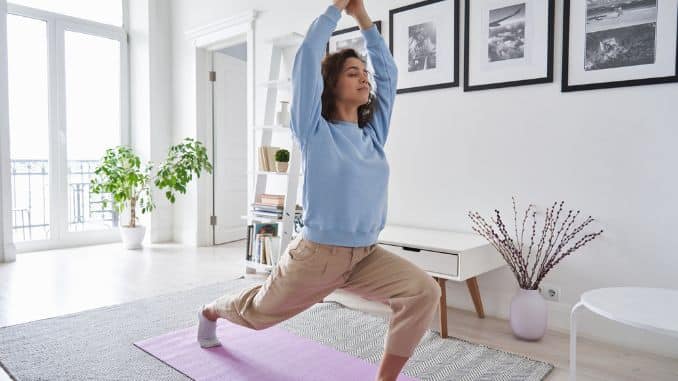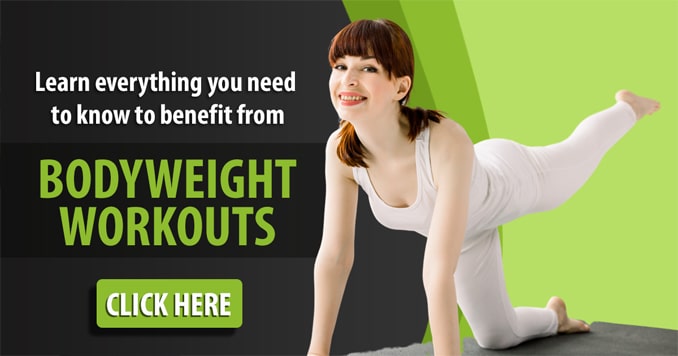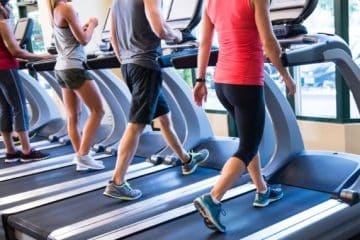Not having gym gear can be a real pain for folks into fitness or anyone just trying to stay active. You know, gym equipment gives you all those cool options and resistance levels. But here's the deal: even without those fancy machines, you can still get a killer workout using your body weight. Initially, the Bodyweight Exercises may seem limited, but when varied and performed correctly, they're highly effective for achieving fitness goals. Let's talk about how to handle the absence of gym equipment and embrace the Benefits of Bodyweight Exercises as your go-to workout buddy.
What Is Body Weight Exercise?
Calisthenics, alternatively referred to as bodyweight exercises, offer a remarkably efficient and adaptable means of physical activity that relies solely on the resistance provided by one's body weight. These exercises offer a holistic approach to fitness, encompassing strength and resistance training, endurance, flexibility, and functional fitness without the need for expensive gym equipment or weights. They appeal to beginners because they can be performed virtually anywhere, making fitness accessible to many individuals.
Key advantages of bodyweight
One of the key advantages of bodyweight movements is their adaptability. Whether you're looking to build muscle, improve cardiovascular health, or enhance overall athleticism, there is a bodyweight exercise. From push-ups and bodyweight squats to planks and lunges, the variety of movements allows individuals to customize their exercise workouts according to their fitness objectives. Additionally, bodyweight exercises promote functional strength, helping individuals improve their ability to perform everyday activities with greater ease and reduced risk of injury. As a result, they are an excellent choice for anyone seeking a cost-effective and efficient way to enhance their physical fitness and well-being.
Benefits Of Bodyweight Exercises
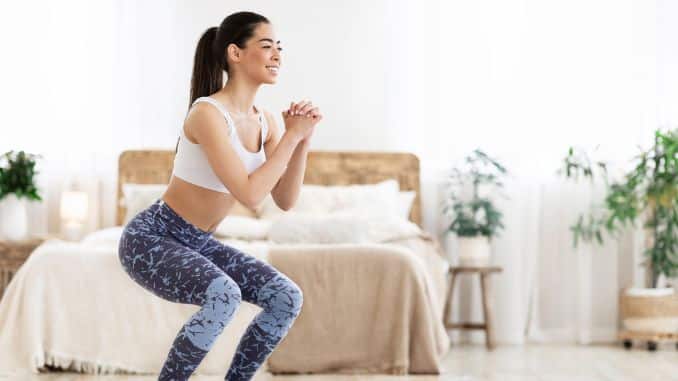
-
Improved Strength And Muscle Development
Bodyweight exercises are highly effective for building and toning muscle. They work various muscle groups, including the chest, shoulders, back, legs, and core. These exercises can be tailored to target a specific muscle group or provide a full-body workout, allowing you to develop balanced strength.
-
Functional Fitness
Bodyweight training often mimics natural movements, making them excellent for improving functional fitness. Functional strength gained from bodyweight exercises can enhance your ability to perform everyday tasks, such as lifting objects, climbing stairs, or bending over.
-
Accessibility And Convenience
One of the biggest advantages is the convenience and accessibility of bodyweight exercises. You can perform them virtually anywhere, whether at home, in a park, or while traveling. Body weight exercises require no need for gym memberships or expensive equipment, making it a cost-effective fitness option.
-
Weight Management And Fat Loss
A regular bodyweight workout routine can contribute to weight management and fat loss by increasing your metabolism and helping to create a calorie deficit when combined with a balanced die. They are an efficient way to burn calories and promote lean muscle mass.
-
Versatility And Variety
There is a wide range of bodyweight workouts to choose from, allowing you to create diverse and engaging workouts. This variety can help prevent workout boredom and plateaus in your fitness progress.
-
Enhanced Flexibility And Mobility
Many bodyweight exercises involve compound movements that promote flexibility and mobility. Over time, improved range of motion can lead to reduced risk of injury and better overall physical health. Exercises like planks and hanging leg raises are particularly effective for core development.
-
Cardiovascular Endurance
Specific bodyweight exercises, such as burpees, mountain climbers, pull-ups, and jumping jacks, are a combination of cardio and strength training. These cardio workouts can help improve endurance and overall cardiovascular fitness.
-
No Age Limit
Bodyweight exercises are inclusive and can be adapted to accommodate people of all ages and fitness levels. with these Benefits of Bodyweight Exercises, which older adults can benefit from, to maintain muscle mass, bone density, and overall health.
-
Progression And Adaptation
As you become elevated in your fitness level, you can make bodyweight exercises more challenging by adjusting variables like repetitions, sets, tempo, and exercise variations. You can also complement these bodyweight exercises with a cardio workout or weight training. This versatility ensures that your workouts remain effective and engaging over time.
Bodyweight Exercise Routine
Warm-up
1. Shoulder Rolls
First, begin in an upright standing position with your feet hip-width apart, maintaining good alignment with your head, shoulders, hips, and legs. Second, engage your core, lift your shoulders upward, then roll your shoulders back until you feel resistance in your shoulder blades. Third, Relax and lower your shoulders to the starting position. Then, Repeat the movement in the opposite direction. Perform with 1 set of 10 repetitions in each direction.
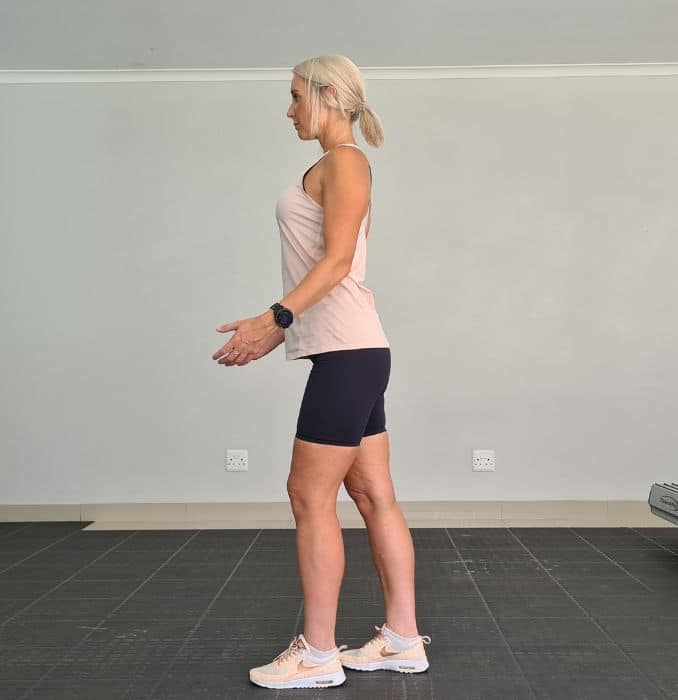 |
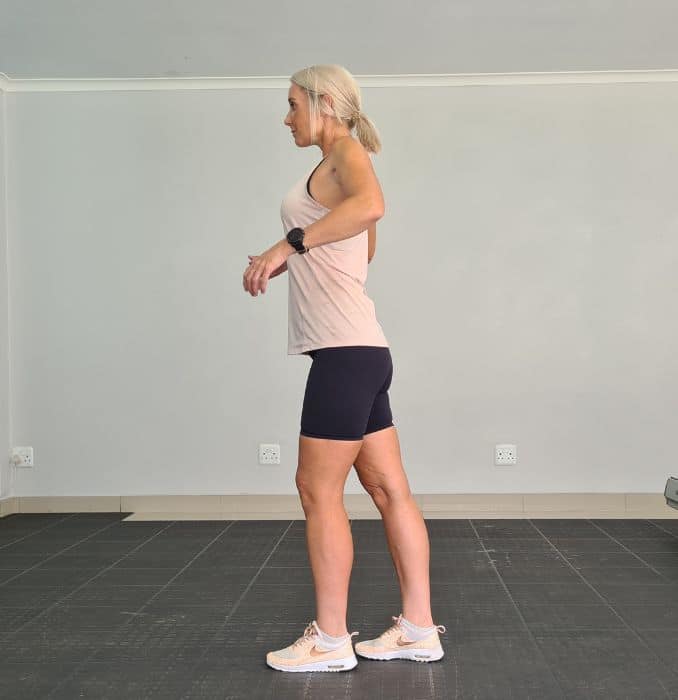 |
2. Standing Twist
Firstly, begin in an upright standing position with your feet hip-width apart, maintaining good alignment with your head, shoulders, hips, and legs. Secondy, place your left arm on your left shoulder and your right arm on your right shoulder. Thirdly, engage your core, then twist a little side to side while keeping your hips locked in the forward position. Then, Repeat the movement. Complete 10 repetitions.
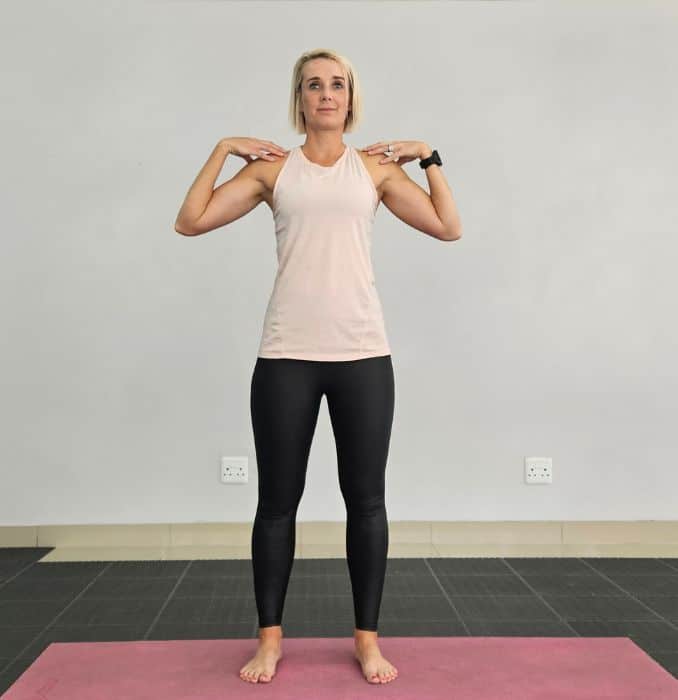 |
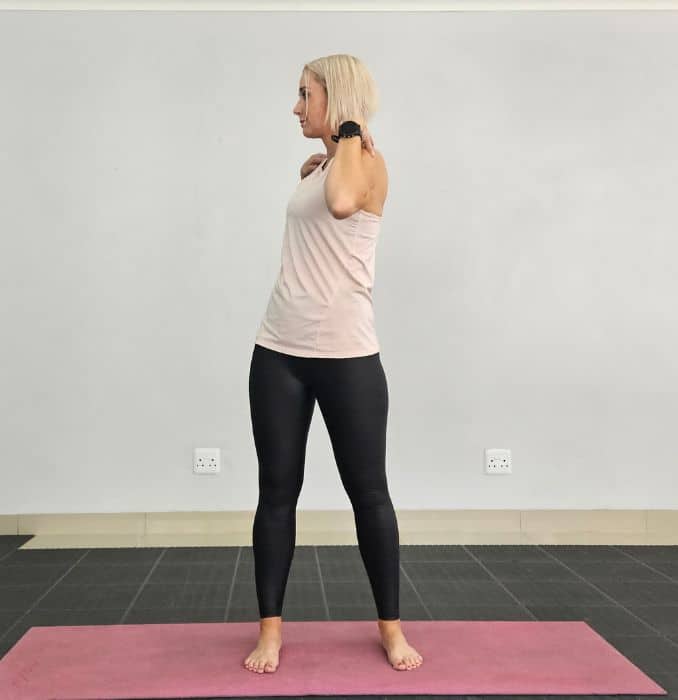 |
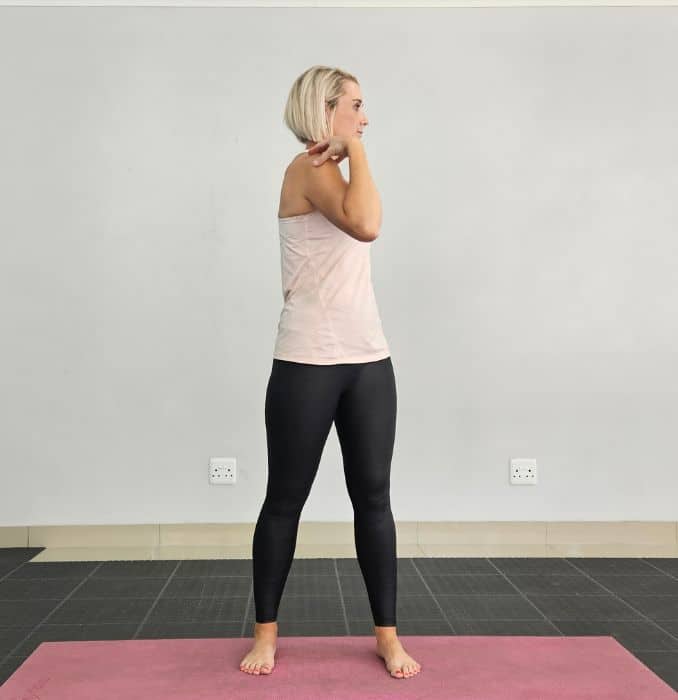 |
3. Squat
First, begin in an upright standing position with your feet shoulder-width apart, maintaining good alignment with your head, shoulders, hips, and toned legs. Second, place your hands on your hips and tighten your abdominal muscles. Third, bend your knees and hinge through your hips to move into a low squat position. Fourth, Keep your knees behind your toes. Lastly, raise back up to an upright standing position, squeezing your glutes at the top position. Start with 1 set of 10 repetitions.
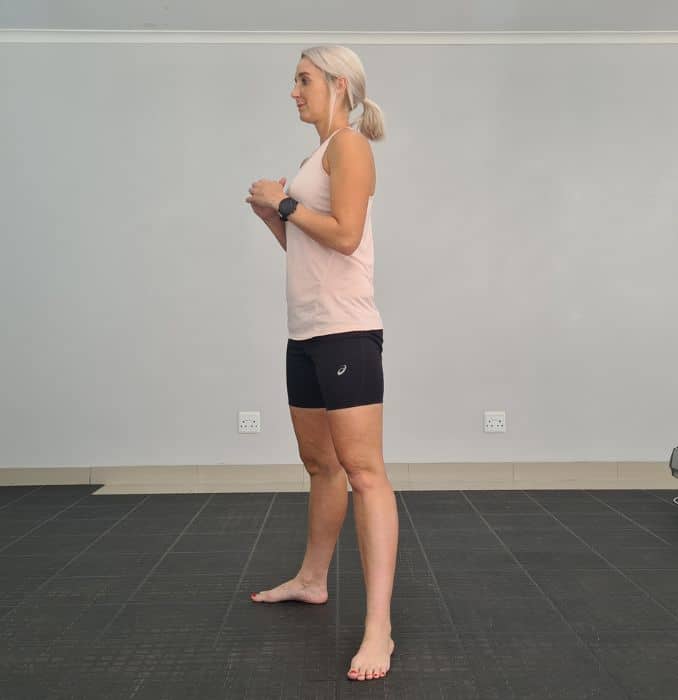 |
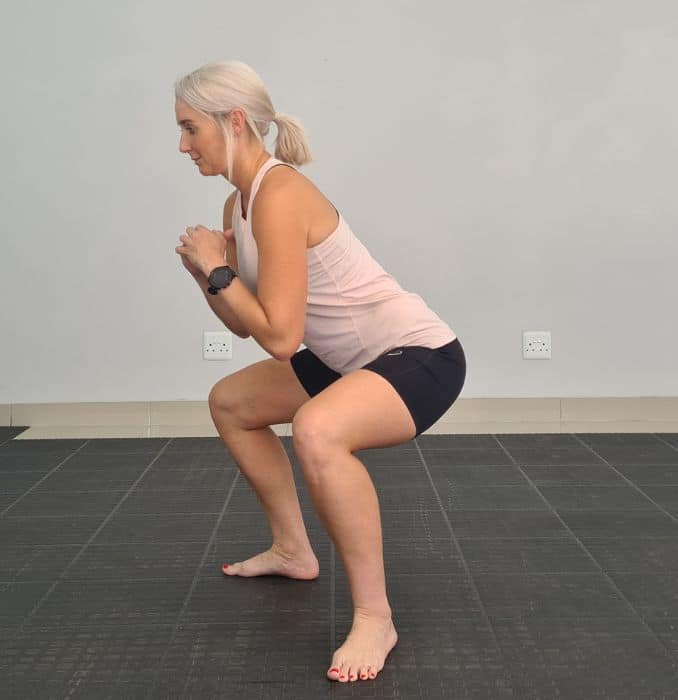 |
4. Lateral Lunge
First, begin in an upright standing position with your feet considerably wider than shoulder-width apart, maintaining good alignment with the head, shoulders, and hips. Second, place your hands on your thighs or place both hands on one thigh and engage your core. Third, bend your left leg to shift your body weight to one side, stacking your hip over your knee and ankle. Finally, push back through your heel to return to the starting position and repeat the movement on the opposite side. Start with 1 set of 10 repetitions, alternating sides.
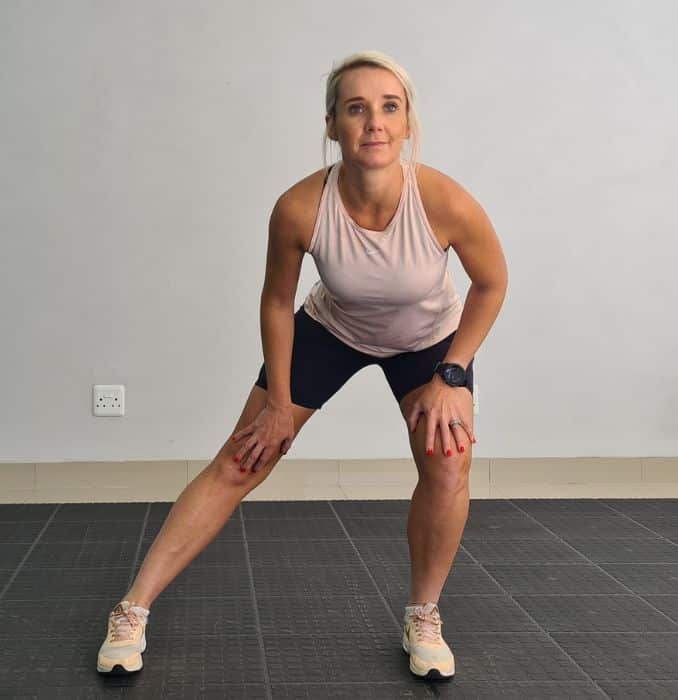 |
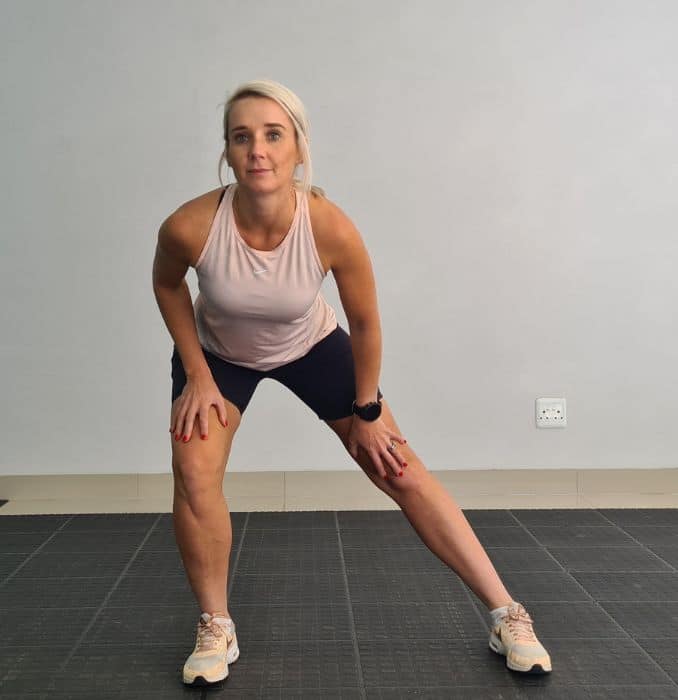 |
5. Standing Hamstring Stretch
Firstly, Begin in an upright standing position, maintaining good alignment with your head, shoulders, hips, and legs. Secondly, straighten one leg and flex your foot so that your toes point upward. Thirdly, engage your core and hinge through your hips to lean your upper body forward, keeping your back straight. Fourthly, hold this position for a few seconds. At this time, straighten back up to return to the starting position and repeat the movement. Start with 1 set of 10 repetitions on each side.
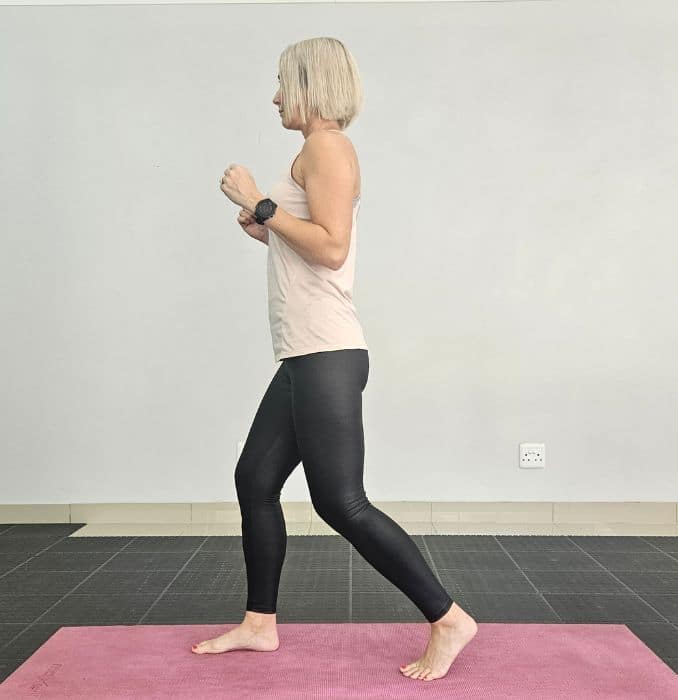 |
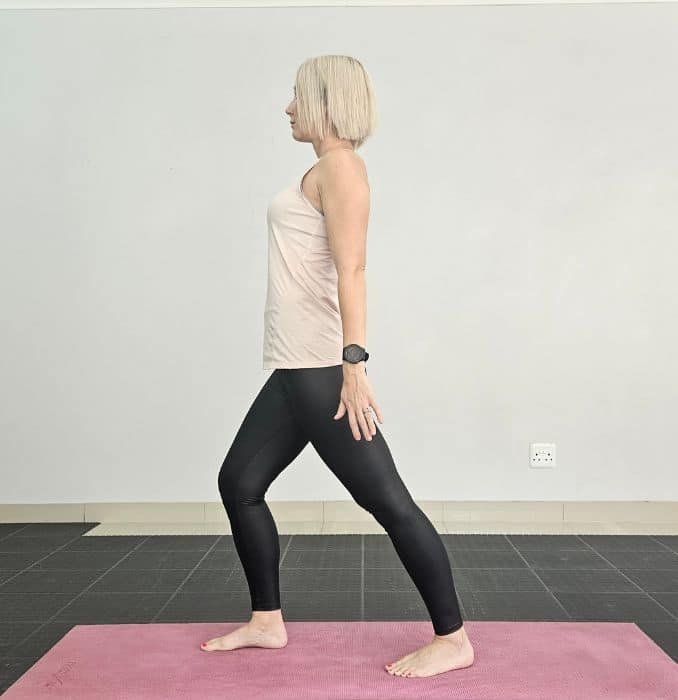 |
6. Standing Hamstring Stretch
First, begin in an upright standing position, maintaining good alignment with your head, shoulders, hips, and legs. Second, bring one foot forward, heel down, and toes pointing upward. Third, while keeping your front leg straight, bend your hips, and reach down towards knee level. Lastly, lift back up and repeat the movement. Start with 1 set of 10 repetitions on each side.
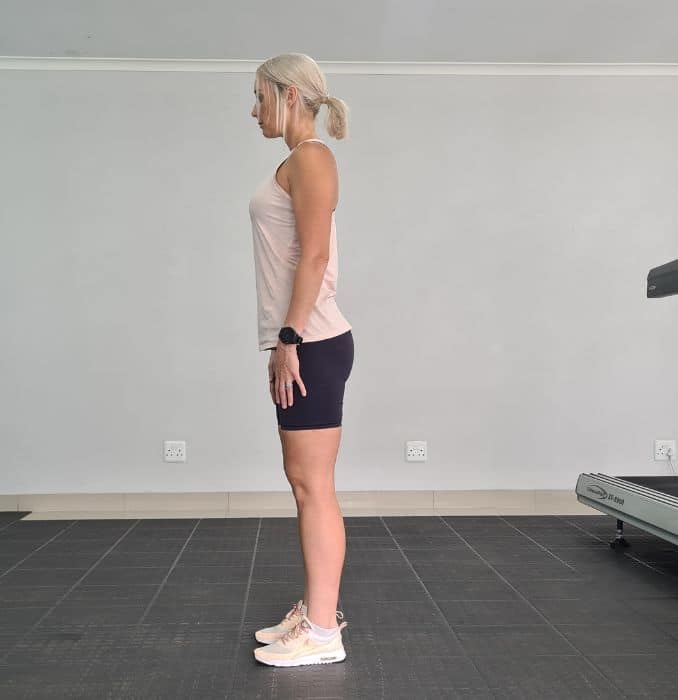 |
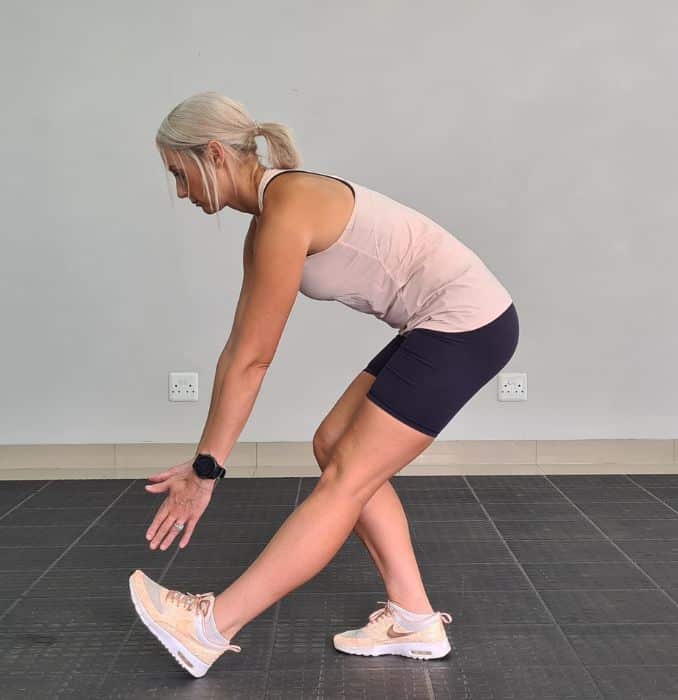 |
Routine
1. Low Squat With Chair
For this exercise, you may use a chair for balance and support.
Firstly, begin in an upright standing position in front of a chair with your feet slightly wider than shoulder-width apart, maintaining good alignment with your head, shoulders, and hips. Secondly, press your palms together in front of your body at chest height and tighten your abdominal muscles. Thirdly, bend your knees and hinge through your hips to lower into a seated position on the chair. Lastly, raise back to an upright standing position, squeezing your glutes at the top. Then, Repeat the movement. Start with 1 set of 10 repetitions.
 |
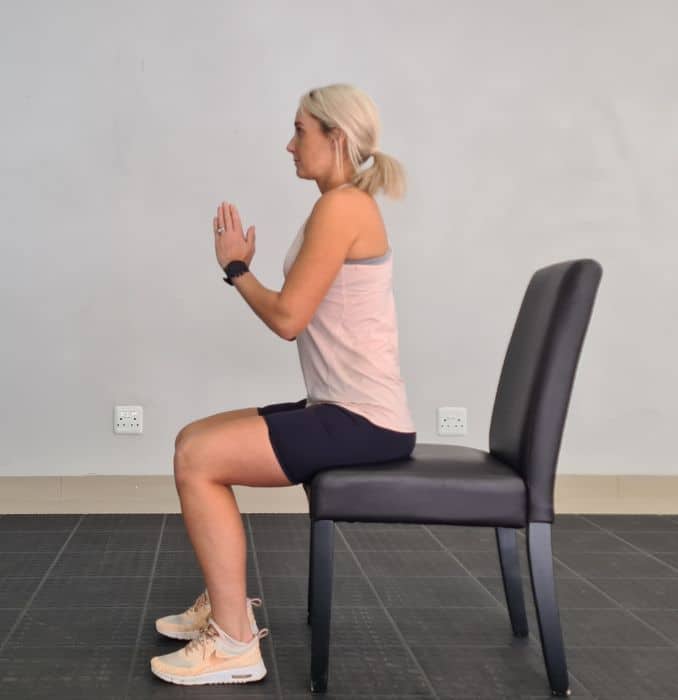 |
2. Lateral Leg Lifts With Chair
For this exercise, you may use a chair for balance and support.
First, begin in an upright standing position with your legs hip-width apart, maintaining good alignment with your head, shoulders, hips, and legs. Second, hold on to the back of the chair with your one hand for balance while you place your opposite hand on your hip. Third, engage your core and lift one leg out to the side, ideally to a 30 to 45-degree angle. Fourth, keep your toes pointing forward. Finally, lower your leg to the starting position and repeat the movement. Start with 1 set of 10 repetitions on each side.
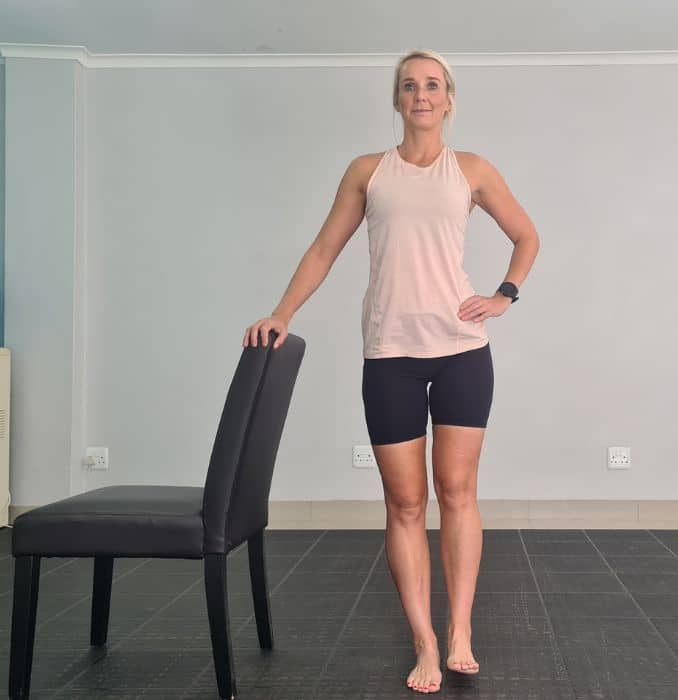 |
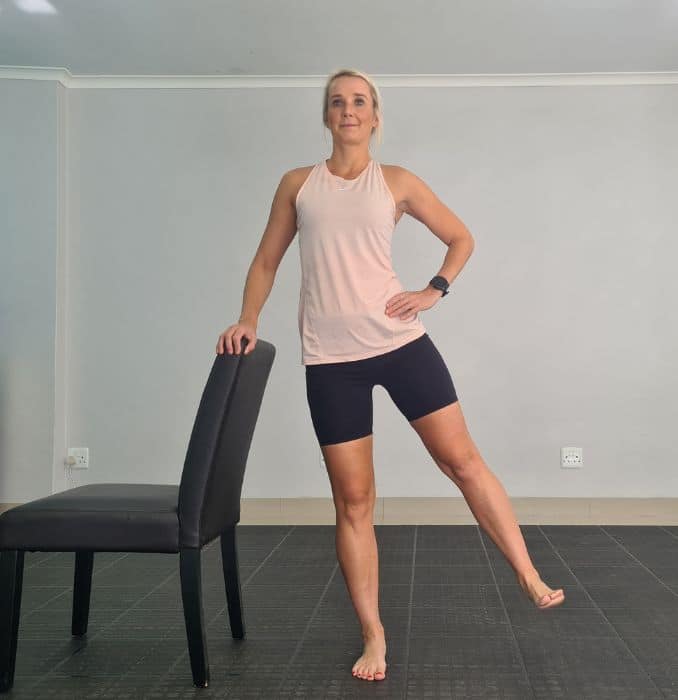 |
2. Knee Drive To Leg Extension
For this exercise, you may use a chair for balance and support.
Firstly, Begin this lower body chair workout in an upright standing position with one hand on the back of a chair for support, maintaining good alignment with your head, shoulders, hips, and legs. Secondly, Take a deep breath and lift one knee up towards your chest, then extend the same leg back behind your body, ideally to be parallel to the floor. Lastly, lower your leg to the starting position and repeat the sequence of movements. Start with 1 set of 10 repetitions on each side.
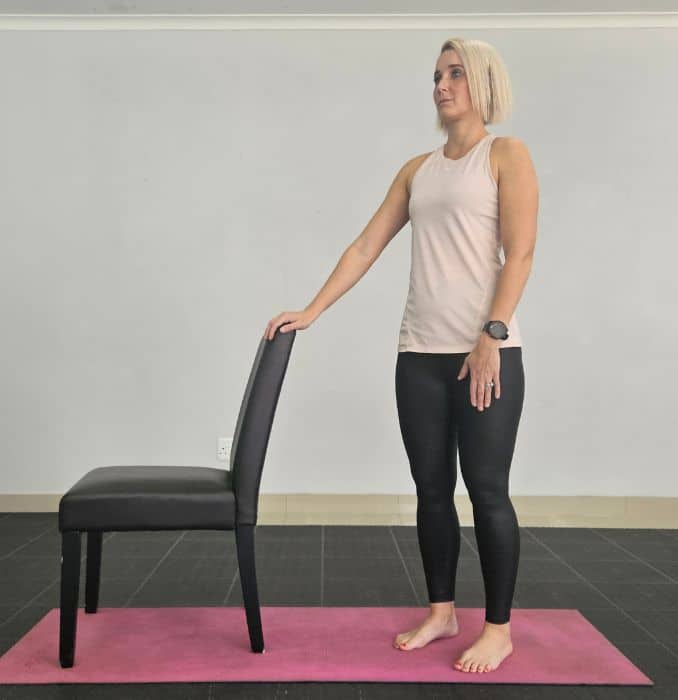 |
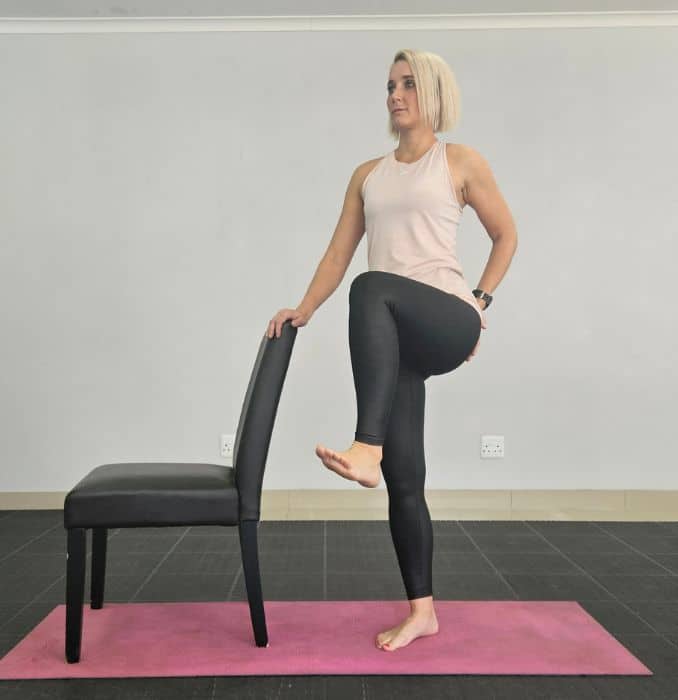 |
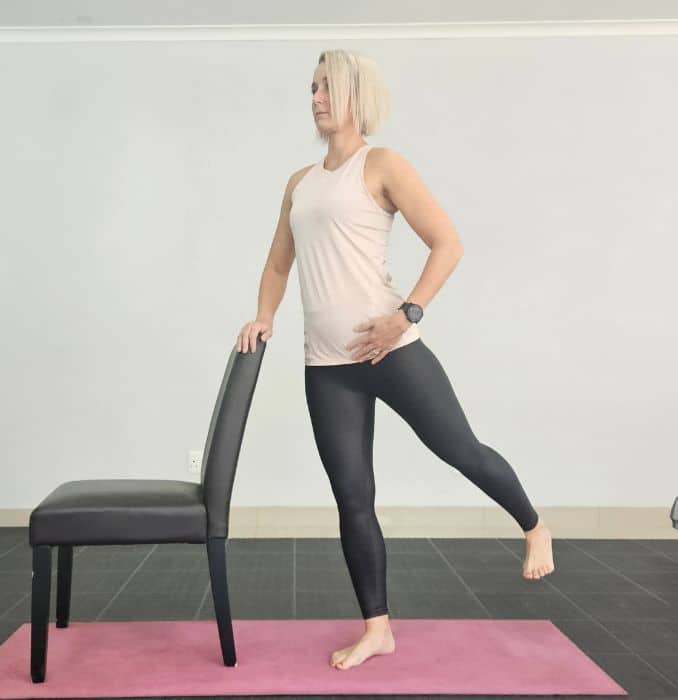 |
Knee Drive to Leg Extension
3. Cat-Cow
First, begin in an upright standing position with your feet hip-width apart, maintaining good alignment with your head, shoulders, hips, and legs. Second, place your hands on your thighs. Third, tighten your abdominal area, tilt your head upward as you arch your mid-back. Then, alternate by rounding out your middle back as you slowly lower your head towards your chest. Start with 1 set of 10 repetitions.
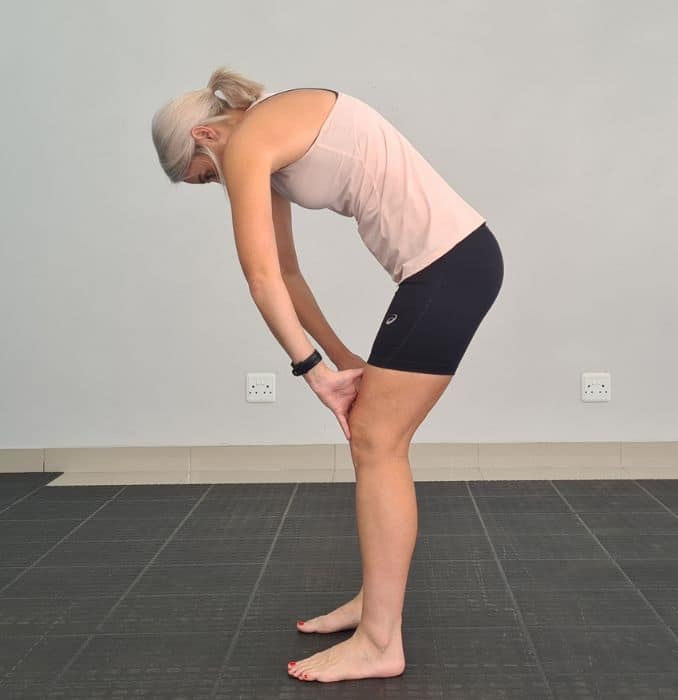 |
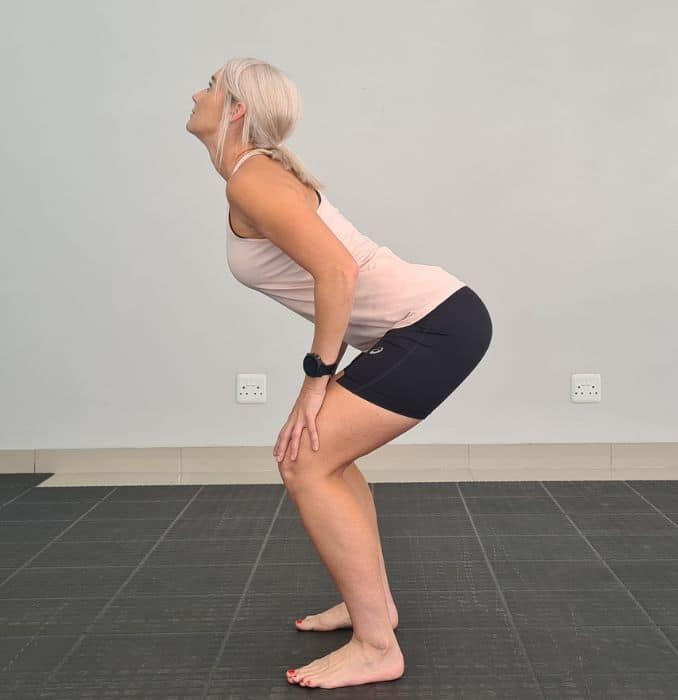 |
Cat-Cow
4. Lunges
For this exercise, you can use the back of the chair, couch, or wall for support and balance.
First, begin in an upright standing position with your feet hip-width apart, maintaining good alignment with your head, shoulders, and hips. Second, hold on to the back of a chair with one hand for balance and engage your core. Third, take a big step back with one foot and lower your back knee down towards the floor, keeping your toes pointing straight ahead. Finally, step back up to an upright standing position and repeat the movement on the opposite side. Start with 1 set of 10 repetitions on each side.
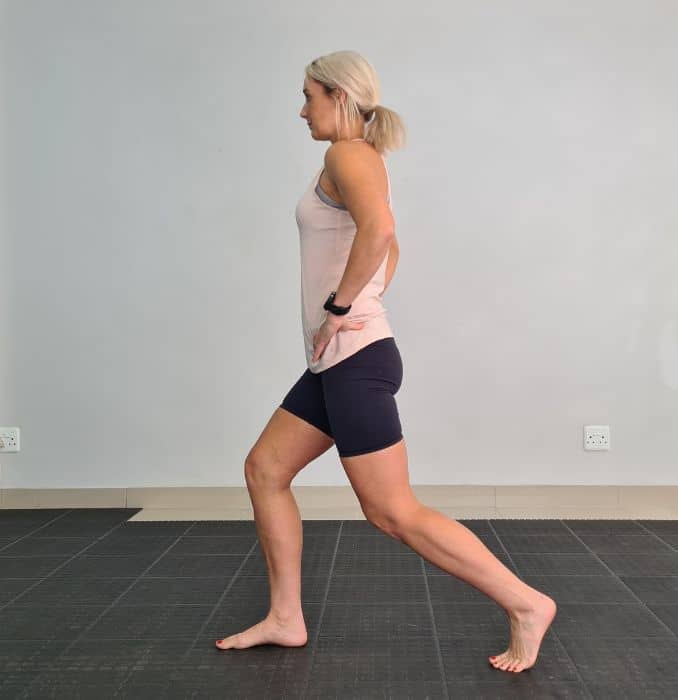 |
5. Chair Lunge
Firstly, begin in an upright sitting position with your feet flat on the floor, maintaining good alignment with your head, shoulders, and hips. Secondly, turn your body so that you are sitting on the front of the chair with only one-half of your seat. Thirdly, extend your outside leg back and place your hand on the back of the chair for support. Fourthly, engage your core and bend your upper body towards the chair, reaching over your head with your opposite arm. Finally, hold this position for several deep belly breaths, in through your nose and out through your mouth. Then, return to the starting position and repeat the movement on the opposite side.
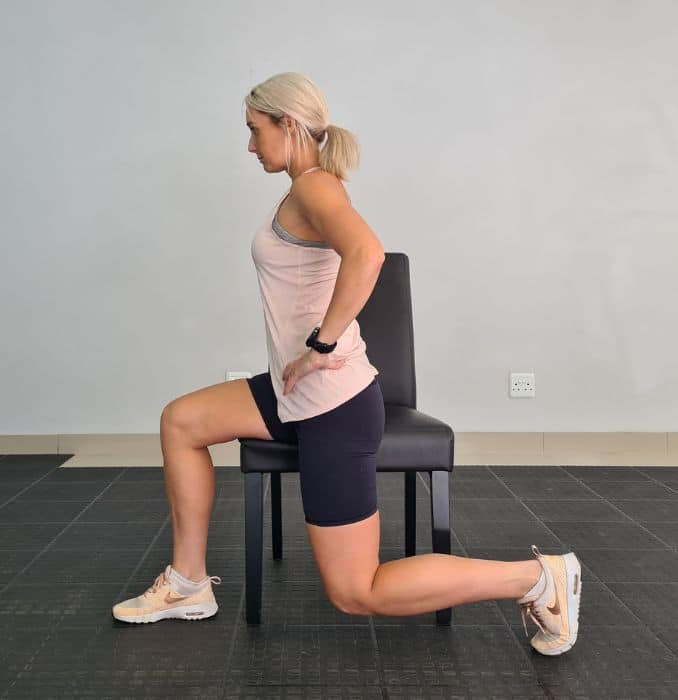 |
6. Figure 4
First, begin in an upright sitting position with your feet flat on the floor, maintaining good alignment with your head, shoulders, and hips. Second, cross one ankle over your opposite knee. Third, engage your core and hinge through your hips to bend your upper body forward. Finally, hold this position for several deep belly breaths, in through your nose and out through your mouth. Then, return to the starting position and repeat the movement on the opposite side.
Extend your legs and cross your ankle over your opposite shin to make this exercise easier.
 |
Frequently Asked Questions
-
Is It Truly Possible To Develop Muscle Through Bodyweight Exercises?
Certainly, you can indeed build muscle through bodyweight exercises. While traditional weightlifting and resistance training are often associated with muscle growth, the Benefits of Bodyweight Exercises can be equally effective when performed correctly and progressively. Building muscle with bodyweight exercises is often called “calisthenics,” it relies on the principle of progressive overload.
-
Is Bodyweight Training Effective?
Yes, bodyweight training is effective, for it has its Benefits of Bodyweight Exercises such as building strength, improving flexibility, enhancing cardiovascular fitness, and achieving fitness goals.
It is flexible enough to suit different fitness levels, offers a diverse array of exercises, and delivers convenience and accessibility, rendering it a valuable and adaptable fitness choice for a wide range of individuals.
Conclusion
Bodyweight exercises offer many benefits that make them a valuable addition to any fitness routine. These exercises empower individuals to build strength, improve flexibility, enhance cardiovascular fitness, and achieve their fitness goals, all without the need for specialized gym equipment. The convenience and accessibility of bodyweight workouts make them an ideal choice for individuals seeking cost-effective and time-efficient ways to stay active and maintain their overall health.
By harnessing the power of one's body weight, these Benefits of Bodyweight Exercises not only transform physical strength but also contribute to enhanced overall well-being and a healthier, more active lifestyle. So, whether in the absence of gym equipment or as a primary component of a fitness regimen, bodyweight exercises truly prove themselves as reliable and effective workout companions.
Here at EFI, we understand that the multitude of different fitness options available on the market today can be incredibly overwhelming. Our 101 Video series is designed to take the guesswork out of any physical fitness endeavors you might pursue. Check out our Bodyweight Workouts 101 now!

